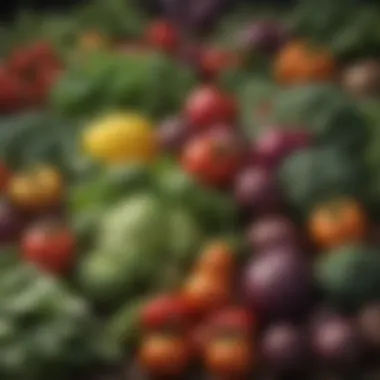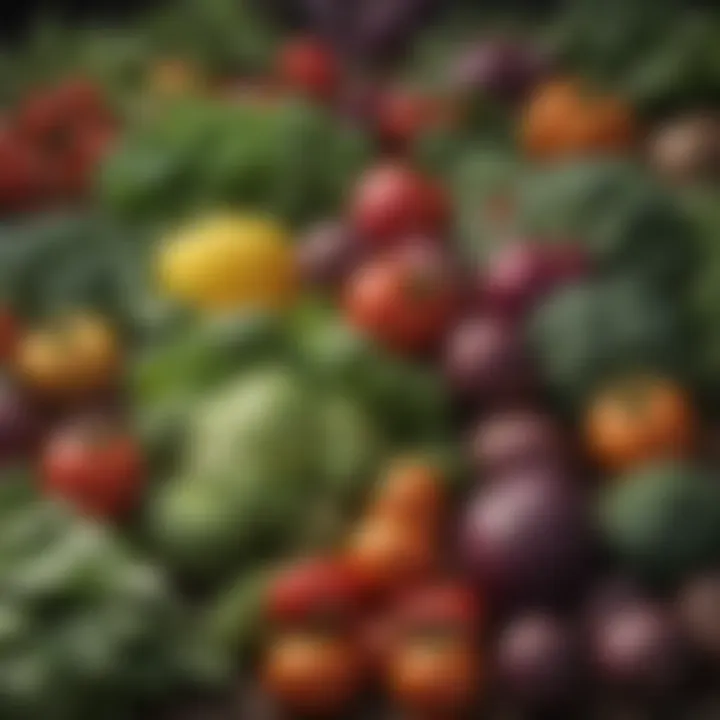Essential Plants for Your Vegetable Garden


Intro
In the quest for a thriving vegetable garden, understanding the right plants to grow is crucial. This guide aims to provide insights into essential vegetables that are not only easy to cultivate but also beneficial for both health and diet. A well-planned vegetable garden can yield fresh produce, optimize space, and contribute positively to a sustainable lifestyle.
Homeowners and gardening enthusiasts can benefit greatly from comprehending the specific conditions that different plants require. This includes factors such as sunlight, soil type, and watering needs. Additionally, the nutritional benefits of each vegetable can influence dietary choices, making it important to select varieties that enhance overall well-being.
Moreover, the article will touch upon critical aspects like planting cycles and companion planting, which can significantly impact the success of the garden. With these elements in mind, both novice and seasoned gardeners can look forward to fruitful harvests and better gardening outcomes.
Design Inspiration
Creating a vegetable garden is not solely about planting; it is an exercise in design and functionality. Selecting the right plants entails understanding not just how they grow, but also how they fit into your outdoor space. The trends in home gardening reflect a growing interest in aesthetics as well as productivity.
Current Trends in Vegetable Gardening
In recent years, there has been a notable shift towards edible landscaping. Homeowners are incorporating vegetables into ornamental gardens, blurring the lines between beauty and functionality. The use of vertical gardening techniques allows for more efficient use of space, bringing style to urban environments. Furthermore, many gardeners are focused on organic practices, choosing plants that naturally deter pests instead of relying on chemical interventions.
Color Schemes in the Vegetable Garden
A vegetable garden can also exhibit a range of colors that enhance its visual appeal. For example, mixing greens with vibrant peppers and deep purple eggplants creates an eye-catching palette.
- Color combinations to consider:
- Vibrant red tomatoes and green basil
- Yellow squash with dark green zucchini
- Purple carrots alongside bright orange calendula
These color arrangements not only make for a beautiful garden but also can attract pollinators and beneficial insects, further aiding in plant growth.
Gardening Techniques
Successful vegetable gardening requires not just knowledge of what to grow, but how to care for these plants effectively. Here are some essential techniques to consider.
Plant Selection and Care
Choosing the right vegetables depends on multiple factors: climate, soil quality, and personal preference. Some vegetables, like lettuce, radishes, and spinach, thrive in cooler weather while tomatoes and peppers prefer warmer conditions. Understanding these needs ensures a more productive garden.
The care of these plants includes routine tasks such as watering, mulching, and protecting against pests. Drip irrigation can save water while providing a steady moisture supply.
Indoor vs. Outdoor Gardening
Deciding between indoor and outdoor gardening can heavily influence the growing environment. Indoor gardening provides greater control over conditions but requires adequate lighting. Outdoor gardening, while subject to the elements, generally offers larger spaces for planting and potential for bigger yields.
Each method has its advantages and challenges. A hybrid approach can also be beneficial, using windowsills for growing herbs while maintaining larger crops outdoors.
"With careful planning and knowledge, any space can transform into a productive vegetable garden."
By thoroughly understanding these aspects, you can create a vegetable garden that not only meets aesthetic desires but also serves practical and nutritional purposes.
Preface to Vegetable Gardening
Vegetable gardening serves as both an essential skill and a rewarding hobby. Cultivating your own food not only enhances the quality of meals but also invites a sense of self-sufficiency. The process of growing vegetables extends beyond simple planting; it incorporates planning, maintenance, and ultimately, harvesting. For homeowners seeking to improve their nutrition, the knowledge of vegetable gardening becomes crucial.
Understanding the basics is the first step in this journey. It allows you to make informed decisions about what to plant and when to plant it. Moreover, the benefits of home-grown vegetables go beyond just taste, delving into health and environmental aspects, which will be discussed further.
In this section, we examine foundational aspects of vegetable gardening. These insights will equip you with the necessary tools to engage successfully with your garden, creating a vibrant and fruitful haven right at home.
Understanding the Basics of Vegetable Gardening
To embark on vegetable gardening, familiarity with essential principles is important. This includes knowledge about soil types, sunlight requirements, and the relationship between different plant species.
Key considerations include:
- Soil Quality: Different vegetables thrive in various types of soil. A well-balanced soil with adequate nutrients is vital for proper growth.
- Sunlight Needs: Vegetables fall into categories based on their sunlight requirements, making it necessary to assess the garden environment.
- Watering Practices: Understanding how much water different plants need can significantly impact their health.
By grasping these basics, you establish a strong foundation for successful gardening. Knowledge of planting seasons, pest management, and harvesting techniques further equips you on this path.
Benefits of Home-Grown Vegetables
Home-grown vegetables present numerous health and environmental advantages. First, they contribute to better nutrition. Garden-fresh produce retains its nutrients longer than store-bought counterparts. Furthermore, you have control over what goes into your food, allowing for organic growing practices that eliminate harmful pesticides.
Additionally, cultivating your own garden fosters a connection to your food source. This awareness can lead to healthier eating habits.
Beyond health, environmental benefits also emerge. Home gardening reduces the carbon footprint associated with transporting food. Each vegetable grown is a small step toward sustainability. This practice can improve soil quality, promote biodiversity, and support local ecosystems.
"Home gardening is a fulfilling practice that benefits both individual health and the environment."
In summary, understanding the basics of vegetable gardening and the benefits of growing your own food lays the groundwork for a successful and fulfilling endeavor. It invites individuals to engage more deeply with their food and environment, empowering them to make informed choices.
Choosing the Right Location
Choosing the right location for your vegetable garden plays a crucial role in determining the success of your gardening efforts. The location impacts sunlight, soil type, and accessibility for maintenance. It is essential to consider these factors to create an optimal environment for your vegetables. A well-planned garden site not only ensures better growth but also reduces the need for additional interventions, such as fertilizers and pesticides.
Sunlight exposure is perhaps the most significant aspect when selecting your garden location. Most vegetables require at least six hours of direct sunlight per day. However, some crops, like leafy greens, can thrive in partial shade. Hence, understanding the sunlight patterns in your chosen area is vital. Likewise, the type of soil in your garden will affect root development and nutrient availability, making it necessary to evaluate soil quality as well.
Maintaining easy access to your garden is also important. This makes regular tasks, such as watering, weeding, and harvesting, more manageable. Plan pathways and layout according to your needs. It encourages you to tend to your garden more often, ultimately resulting in healthier plants and a better yield.
Assessing Sunlight Exposure
Assessing sunlight exposure should start by observing your intended garden area at different times of the day. Identifying where sunlight falls during morning, noon, and afternoon can give you valuable insights.
Key considerations for sunlight exposure:
- Duration: Look for a site that receives at least six hours of full sunlight daily.
- Obstructions: Examine nearby trees, buildings, or other structures that may cast shadows on your garden. These can significantly reduce the sunlight your plants receive.
- Microclimates: Recognize that different areas can experience variations in light and temperature. If you have the opportunity, consider creating multiple small beds to take advantage of these microclimates.
After assessing your sunlight exposure, you can make informed choices on which vegetables to plant based on their sunlight needs.
Evaluating Soil Quality
Evaluating soil quality is a layered process. Begin by observing its texture, color, and drainage capabilities. Healthy soil must be well-draining but retain some moisture. A simple way to check this is to grab a handful of moist soil and squeeze it. If it crumbles easily, the drainage is suitable.
Aspects to consider for soil quality:
- pH Level: The ideal pH for most vegetables lies between 6 and 7. You may need to perform a soil test to determine its acidity or alkalinity. This information helps you amend the soil accordingly.
- Nutrient Content: Testing for essential nutrients such as nitrogen, phosphorus, and potassium can inform your fertilization strategy. High-quality soil should have a good balance of these elements, promoting healthy growth.
- Organic Matter: Incorporating compost or well-rotted manure improves soil structure and fertility. This enhances moisture retention, boosting your plants' access to water and nutrients.
Always remember that good soil is foundational for a successful garden. Regularly improving soil quality through testing and amending will result in better growth and yield of your vegetables.
Essential Vegetable Varieties
In the realm of vegetable gardening, selecting the right varieties is a crucial step toward a successful harvest. Essential vegetable varieties encompass a range of plants that not only thrive in home gardens but also contribute significantly to nutrition and culinary versatility. When choosing these plants, one must consider factors such as growth conditions, maturity time, and seasonal adaptability. Popular selections enhance both flavor and aesthetic appeal, elevating the gardening experience.
Understanding the unique characteristics of each plant type allows gardeners to plan effectively. combining flavors and maximizing space in their gardens leads to a more fruitful yield. Thus, examining the primary categories of essential vegetable varieties is essential for both novice and experienced gardeners.
Leafy Greens
Leafy greens are a vital choice for vegetable gardens, offering high nutritional value and quick growth cycles. They are ideal for beginners due to their adaptability. Below are specific leafy greens worth exploring:
Lettuce
Lettuce is a staple leafy green, valued for its crisp texture and mild flavor. It grows quickly, often within 30 days from seed to harvest. This makes it an excellent choice for gardeners seeking quick results.
One of the key characteristics of lettuce is its diverse varieties, including butterhead, romaine, and loose-leaf types. Each of these offers different flavors and textures, catering to various culinary uses.
Lettuce's major advantage lies in its ability to thrive in cooler weather, enabling early spring or fall planting. However, it is sensitive to heat and may bolt if temperatures rise too quickly. Thus, proper timing is crucial.
Spinach
Spinach is celebrated for its nutrient density, rich in vitamins A, C, and K. This leafy green is not only versatile in dishes but also easy to cultivate. Spinach generally grows well in cool conditions, which encourages faster growth and better taste.


What sets spinach apart is its capacity to be harvested multiple times. As a cut-and-come-again crop, gardeners can continually harvest leaves, enhancing overall yield. One downside is its susceptibility to pests like aphids, but proper management can mitigate this issue.
Kale
Kale is recognized for its robust flavor and incredible health benefits, being high in antioxidants and fiber. It is particularly resilient to cold weather and often improves in flavor after frost. Kale can be harvested repeatedly, as the outside leaves mature while new growth appears from the center.
A unique feature of kale is its variety of colors and leaf types, ranging from curly to flat. However, some kale varieties can be tough and fibrous, depending on growing conditions and maturity at harvest.
Root Vegetables
Root vegetables are indispensable in a vegetable garden due to their hardiness and ability to store well. These crops provide essential nutrients and energy when stored correctly. Below are some notable root vegetables:
Carrots
Carrots are loved for their sweetness and crunch. They develop well in loose, well-draining soil, ideally with neutral pH. The key characteristic is their vibrant colors, adding appeal to any dish.
One significant advantage of carrots is that they provide measurable garden space efficiency. Multiple varieties such as ‘Nantes’ and ‘Imperator’ allow for diversity in taste and cooking applications. However, they can be slow to germinate, requiring patience.
Radishes
Radishes are known for their fast growth, often ready to harvest within a month. Their crisp texture and peppery flavor make them popular in salads. Radishes are also an excellent choice for succession planting, maximizing garden space.
A unique aspect is the range of colors and varieties available, from red to black or even white. The primary disadvantage is their vulnerability to soil quality; poor conditions can hinder growth and size.
Beets
Beets are versatile, bringing color and nutrition to the garden. They are rich in vitamins and can be consumed cooked or raw. Beets thrive in cooler temperatures, similar to carrots, making them ideal for early spring and fall planting.
The unique feature of beets is that both the roots and greens are edible. Their added toughness means they can store well for long periods. However, they require careful thining during sowing to ensure they develop properly.
Fruiting Plants
Fruiting plants are the centerpiece of many home gardens. They provide an abundance of food and variety in recipes. Their successful cultivation is often tied to a gardener's knowledge of temperature needs and care. Below are some key fruiting plants:
Tomatoes
Tomatoes are among the most popular garden crops, valued for their flavor and versatility. They require full sun and well-draining soil for optimal growth. Their defining characteristic is the ability to produce multiple fruit types, such as heirlooms and cherry varieties.
Tomatoes can be grown in pots or open soil, offering flexibility in planting locations. The downside is their susceptibility to blight and pests, necessitating vigilance in care throughout the growing season.
Peppers
Peppers, ranging from sweet to hot varieties, are favored for their culinary uses. They thrive in warm conditions and can produce an abundance of fruit. A key feature of peppers is their vibrant colors, which add visual interest to gardens.
An advantage of peppers is their relatively easy maintenance compared to other fruiting plants. However, they may require staking for larger varieties to support fruit weight.
Eggplant
Eggplant is recognized for its unique flavor and texture, often used in various global cuisines. It requires warm temperatures and consistent watering for best results. The distinctive glossy skin is appealing in dishes and enhances their aesthetic value in gardens.
One disadvantage is its susceptibility to pests like spider mites. Effective pest management is essential for a successful harvest.
Legumes
Legumes are an important addition to vegetable gardens due to their nitrogen-fixing properties. They enrich soil health, contributing to overall garden sustainability. Here are key categories of legumes:
Beans
Beans, such as green beans and kidney beans, are prized for their protein content and quick maturity. They thrive best with support structures to allow climbing growth. Beans contribute significantly to garden diversity.
A noteworthy advantage is the vast variety available, allowing choices based on regional preferences. However, they may attract pests that can harm other plants if not managed.
Peas
Peas are another favorite, providing sweet and crisp pods. They are cool-season crops that pair well with various plants, enhancing companion planting efforts. Their quick growth is a significant benefit to gardeners.
One downside is that peas require more frequent watering during dry spells to ensure optimal growth. This attention to moisture is vital.
Lentils
Lentils are excellent for gardeners looking to grow protein-rich crops. They thrive in non-clay soils and are resilient options during various growing seasons. In addition to their nutritional benefits, they can efficiently enhance soil structure.
A unique feature is their low maintenance; however, they may compete with weeds if not monitored closely.
By understanding these essential vegetable varieties and their specific characteristics, gardeners can optimize their choices and ensure fruitful, diverse harvests.
Understanding Planting Seasons
Understanding planting seasons is crucial for a successful vegetable garden. The timing of planting affects growth rates, harvests, and even the persistence of pests. Each region has a distinct climate, dictating when certain vegetables can be planted. Knowing the planting seasons means maximizing the potential of your garden. It helps in selecting the right crops and preparing soil and resources appropriately.
Key Elements to Consider:
- Climate Zones: Different regions have varied climates, influencing what can be planted when. Familiarizing yourself with your local zone helps in planning effectively.
- Frost Dates: Understanding the last frost in spring and first in autumn is vital. This knowledge protects tender plants during unexpected weather.
- Days to Maturity: Each vegetable has a specific growth period. Knowing how long it takes for different seeds to mature helps in planning succession planting.
By grasping these elements, gardeners can ensure that they plant crops at the optimal time, resulting in healthier plants and bountiful harvests.
Spring Planting Guide
Spring is a significant season for vegetable gardening. It is the time when the soil begins to warm and the danger of frost decreases. In many areas, this means it is time to plant a variety of vegetables. Below are essential steps for spring planting:
- Soil Preparation: Before sowing, prepare the soil. Clear debris, loosen the soil, and mix in compost or fertilizers to enrich its nutrient content.
- Choosing Seeds: Select seeds that thrive in spring conditions. Varieties like lettuce, spinach, and radishes are often the first to plant.
- Direct Seeding vs. Transplanting: Decide whether to seed directly into the ground or transplant seedlings started indoors. Each method serves different purposes based on growth speed and climate.
"Timing in gardening is everything. Plant too early or too late, and you may lose your harvest."
Proper timing and technique not only encourage strong growth but also help in achieving early harvests. Timing leads to an efficient gardening experience.
Fall Planting Considerations
Fall is often overlooked, yet it offers a chance for another round of vegetables. Cool temperatures can be ideal for many crops, allowing for better growth conditions. Here are some points to consider when planting in fall:
- Seasonal Vegetables: Choose crops that are suited for fall, such as kale, carrots, and turnips. These plants tend to thrive in cooler weather and can even improve in flavor after frost exposure.
- Soil Care: Ensure the soil is still fertile as the growing season ends. Additional compost can enhance nutrients in the earth, preparing it for the last planting of the year.
- Timing: Pay attention to the first frost date in your zone. Planting dates should be calculated backward from this date to ensure crops mature in time.
By employing these strategies, gardeners can extend their harvest and enjoy fresh vegetables well into the colder months. Fall planting enriches the gardening experience and allows for diverse vegetable options.
Soil Preparation Techniques
Soil preparation is a crucial aspect of successful vegetable gardening. It sets the foundation for healthy plant growth. Understanding how to prepare the soil can lead to better yields, more nutritious vegetables, and overall gardening success. Preparing the soil involves testing its quality and making necessary amendments to enhance its fertility. This process can greatly impact the growth of vegetables, making it essential for any gardener.
Soil Testing
Soil testing is the first step in the soil preparation process. By testing the soil, you gain valuable information about its pH, nutrient levels, and overall composition. To conduct a soil test, you can use a soil testing kit, which is readily available at garden centers, or send a sample to a laboratory for precise analysis.
The results of the soil test provide insight into existing nutrient deficiencies or excesses. For example, if the soil is too acidic, it may hinder plant growth. In such cases, lime can be added to adjust the pH levels. Likewise, a deficiency in nitrogen, phosphorus, or potassium can be addressed through the application of appropriate fertilizers.
"Understanding your soil is fundamental to growing healthy vegetables."
Regular soil testing is advisable. It allows gardeners to monitor changes over time and adapt their strategies accordingly. This ongoing assessment ensures that the soil remains healthy and productive, maximizing the return from your gardening efforts.
Amendments and Fertilization
After analyzing the soil, the next step is to make appropriate amendments. Soil amendments improve the physical structure and nutrient content of the soil. Common amendments include organic matter such as compost or well-rotted manure, which enhances soil fertility and water-holding capacity.
Fertilization is another vital consideration. Depending on the results from the soil testing, you may need to apply chemical or organic fertilizers. Chemical fertilizers provide a quick nutrient boost, but can potentially harm beneficial microorganisms if used excessively. Organic fertilizers, on the other hand, release nutrients slowly and contribute to long-term soil health. Using a combination of both can sometimes be beneficial, depending on the specific needs of your garden.
Here are some common amendments and their benefits:
- Compost: Increases soil fertility and improves texture.
- Peat moss: Enhances moisture retention and aeration.
- Lime: Raises pH in acidic soils, making nutrients more available.
- Sulfur: Lowers pH in alkaline soils.


Ultimately, attention to soil preparation leads to better plant health, improved crop yields, and a more sustainable gardening practice. By investing time in preparing your soil, you lay a stable groundwork for a thriving vegetable garden.
Be sure to continually evaluate your soil throughout the growing season, making adjustments as needed to keep your garden flourishing.
Watering Practices
Watering is a fundamental aspect of gardening, particularly for vegetable gardens. It ensures that plants receive the essential moisture they require for growth, supporting their overall health and productivity. Proper watering practices are not just a routine task; they play a critical role in the success of your garden. Understanding how to water effectively can minimize waste and maximize the vitality of your plants.
Irrigation Methods
There are several irrigation methods suitable for vegetable gardens, each with its advantages and drawbacks.
- Drip Irrigation: This method delivers water directly to the roots of plants through a series of tubes and emitters. It minimizes water waste and reduces the risk of fungal diseases since the foliage remains dry.
- Soaker Hoses: Porous hoses can be laid on the ground or buried under mulch. They allow water to seep slowly into the soil, promoting deep root growth.
- Sprinklers: While effective for covering large areas, sprinklers can lead to water loss through evaporation and may wet the foliage, increasing disease risk.
- Hand Watering: Using a hose or watering can is simple and allows for targeted watering. However, it can be labor-intensive and may lead to inconsistent moisture levels.
Choosing the right method depends on factors such as garden size, plant type, and available time. Each method requires consideration of efficiency, moisture delivery, and how it fits into your overall gardening plan.
Watering Schedules
Establishing an effective watering schedule is vital for maintaining plant health. Overwatering or underwatering can stress plants and lead to poor yields.
- Morning Watering: Watering early in the day allows plants to absorb moisture before the heat of the day. This method reduces evaporation and keeps foliage dry, which helps prevent diseases.
- Deep, Infrequent Watering: Instead of watering lightly every day, aim for deep watering every 2-3 days. This practice encourages roots to grow deeper into the soil, making plants more resilient in hot weather.
- Seasonal Adjustments: Monitor rainfall and temperature changes to adjust your watering schedule accordingly. During hot months, plants may need more water, while cooler periods may require less.
It is important to check the moisture level of the soil before watering. Stick your finger into the soil about an inch deep; if it feels dry, it’s time to water.
Companion Planting Strategies
Companion planting strategies form a vital aspect of successful vegetable gardening. This practice is rooted in the concept of growing different plants in close proximity for mutual benefit. It provides a natural way to enhance productivity, improve soil health, and discourage pests without resorting to chemical solutions. By understanding how different plants can complement each other, gardeners can create a thriving ecosystem that fosters growth and minimizes problems.
Benefits of Companion Planting
Companion planting offers several key advantages:
- Pest Control: Certain plants can repel pests naturally. For example, marigolds are known to deter nematodes and aphids, helping keep problematic insects away from your vegetables.
- Nutrient Enhancement: Some plants can enrich the soil by fixing nitrogen, such as legumes. This benefit rejuvenates the soil for surrounding plants.
- Space Optimization: Companion planting allows for better utilization of garden space. You can plant taller plants alongside shorter ones for optimal sunlight exposure without overcrowding.
- Pollinator Attraction: Flowers that attract pollinators can increase the yield of nearby vegetable plants. For instance, planting lavender or borage can bring in bees and butterflies, vital for fruit set.
"Companion planting is more than just aesthetics; it’s about creating an ecosystem where plants support each other."
Examples of Successful Pairings
To get started with companion planting, consider these effective pairings:
- Tomatoes and Basil: Basil not only enhances the flavor of tomatoes, but it also repels whiteflies and aphids. This duo thrives together, making them a common sight in many gardens.
- Carrots and Onions: Carrots and onions have different root structures, allowing them to share space without competing for nutrients. The onion's scent can also deter carrot flies.
- Corn, Beans, and Squash (Three Sisters): This traditional Native American combination maximizes space and resources. Corn provides a natural trellis for beans, while squash covers the ground to suppress weeds.
- Cabbage and Dill: Dill attracts beneficial insects that prey on cabbage pests, helping keep cabbage plants healthy and vigorous.
By implementing these strategies, gardeners can create a harmonious and productive vegetable garden.
Pest Management Techniques
Pest management is a crucial aspect of vegetable gardening. It involves controlling the population of pests to minimize their impact on crops. Effective pest management techniques can lead to healthier plants and better yields. Neglecting pest control can result in significant damage to your garden and reduce the quality of harvest. Moreover, understanding and implementing these techniques helps in creating a sustainable gardening practice, preserving the ecosystem around your garden while ensuring a fruitful outcome.
Pest management can be complex due to the variety of pests that can plague vegetable gardens. This section focuses on integrated pest management, which combines various strategies for optimal results, and identifies common pests that gardeners should be vigilant about.
Integrated Pest Management
Integrated Pest Management (IPM) is an ecological approach to pest control that considers the lifecycle of pests and their natural enemies. It focuses on long-term prevention and control rather than relying solely on chemical treatments.
Key aspects of IPM include:
- Monitoring: Regular inspection of plants to detect early signs of pest infestations.
- Identification: Knowing what pests are present, and understanding their behavior and life cycle.
- Prevention: Implementing practices like crop rotation, companion planting, and maintaining healthy soil to deter pests.
- Control Methods: Using a combination of biological, cultural, and chemical controls when necessary.
By using IPM, gardeners can reduce reliance on harmful pesticides. Instead, they can focus on sustainable methods that promote a balanced ecosystem in their gardens.
Common Pests to Watch For
Identifying common pests is important for effective management. Here are some of the most frequent pests that can infest vegetable gardens:
- Aphids: Small insects that suck the sap from plants, causing leaves to curl and yellow.
- Caterpillars: Larvae of moths or butterflies that can chew through leaves, presenting a risk to various vegetables.
- Whiteflies: Tiny winged insects that also suck plant juices, leading to wilting and stunted growth.
- Spider Mites: Microscopic pests that create webs and cause speckled leaves due to sap extraction.
- Slugs and Snails: Mollusks that leave holes in leaves, commonly found in damp environments.
Being aware of these pests allows gardeners to monitor their presence closely. Early detection is vital in implementing effective management strategies. Regular inspections and quick action can save a garden from serious damage.
"Proper pest management is not just about eradication; it's about achieving balance."
Harvesting Your Vegetables
Harvesting your vegetables is a crucial phase in the gardening process. It is not merely about picking produce when it looks ready; it involves understanding the characteristics of each vegetable and determining the optimal time for harvesting. The benefits are significant. When vegetables are harvested at the right time, they are often more flavorful, nutritious, and appealing. It is also essential to recognize that different vegetables have varying signs of ripeness, meaning that a gardener must pay close attention to be truly successful.
A timely harvest ensures that vegetables do not over-ripen or decay on the plant. This can lead to wasted efforts and potential disease exposure. Harvesting also encourages further production in some plants, especially perennials and certain annuals, which assists in maximizing yield. Therefore, knowing when and how to harvest is vital for both the quantity and quality of your vegetables.
Understanding Ripeness
Understanding ripeness includes recognizing visual indicators and considering texture and taste. Each vegetable has its specific signs that help determine if it is ready for picking. For instance,
- Tomatoes should be fully colored and slightly firm to the touch.
- Bell peppers are best harvested when they have reached their full size and color.
- Carrots are ready to be pulled when they are about an inch or two in diameter.
In some cases, you might also need to consider seed maturity, as evident in peas and beans. This means that while the vegetable may look plump, the seeds inside should be fully developed for optimal taste and nutrition.
"Harvesting at the right moment can greatly enhance the flavor and nutritional value of your vegetables."
Techniques for Harvesting
There are several techniques suitable for harvesting different types of vegetables. Employing the right method is essential to minimize damage and ensure the longest shelf life.
- Cutting: For leafy vegetables like lettuce and kale, cutting the leaves with a sharp knife or scissors can help prevent tearing.
- Twisting and pulling: This method works well for vegetables like radishes and onions, where a gentle twist can facilitate easier removal from the soil.
- Hand-picking: This is ideal for delicate produce like tomatoes and berries to avoid bruising.
- Using tools: For larger fruits and vegetables, such as pumpkins or squash, using a harvesting tool can prevent damage to the plant and facilitate easier gathering.
After harvesting, ensure to handle your produce gently and store them properly to extend their freshness. Taking care during the harvesting process will promote a more bountiful garden in the future.
Post-Harvest Handling
Post-harvest handling is crucial in maximizing the benefits of your vegetable garden. This phase encompasses all activities that occur after harvesting, with focus on how to maintain the quality of your produce. Effective post-harvest techniques can significantly impact the freshness, taste, and nutritional value of your vegetables. Understanding these methods not only extends the viability of your crops but also enhances your overall gardening experience.
The main benefits of proper post-harvest handling include maintaining flavor and nutrients, preventing spoilage, and maximizing storage life. When vegetables are harvested, they begin to lose moisture and nutrients. Hence, applying appropriate techniques can effectively slow down this process and keep your produce fresh for a longer time, making it an essential aspect of home gardening.
Storage Practices
Storage practices are a fundamental element of post-harvest handling. The right method can determine how long your vegetables last and their quality at the time of consumption. Each type of vegetable has specific storage needs based on factors like moisture content and temperature sensitivity. Here are several key practices:
- Keep vegetables cool: Many crops benefit from cool storage environments, which help slow down respiration and decay.
- Use breathable containers: Plastic bags can trap moisture, leading to rot. Instead, use mesh bags or crates that allow air circulation.
- Monitor moisture levels: Too much humidity encourages mold growth; too little can lead to wilting. Aim for a balance suitable for each vegetable.
Preservation Methods
Preservation methods help extend the availability of your harvested vegetables throughout the year. Two popular techniques are canning and freezing, each offering distinct characteristics and benefits.
Canning
Canning is a preservation method that involves packing vegetables in jars and heat-processing them to create a sealed environment. This technique contributes significantly to storing vegetables up to several years. The key characteristic of canning is its long shelf life, making it a popular choice in home gardening. One unique feature of canning is that it preserves the taste and nutrients when done correctly. However, it does require careful attention to ensure safety, especially regarding acidity levels.
Advantages:
- Long-term storage
- Retains flavor and valuable nutrients
Disadvantages:
- Requires equipment and knowledge to ensure safe preservation
- Potential reduction in texture quality compared to fresh produce
Freezing
Freezing is another preservation method that involves lowering the temperature of vegetables to halt bacterial growth and enzyme activity. This method is favored for its simplicity and efficiency. The key feature of freezing is that it can be done without sophisticated equipment; basic freezer bags and containers suffice. A major advantage of freezing is that it often retains the original texture and flavor of many vegetables even after thawing.


Advantages:
- Easy to do at home with minimal equipment
- Maintains flavor and texture well
Disadvantages:
- Some vegetables may require blanching before freezing to retain color and nutrients
- Storage times should be monitored to prevent freezer burn
Implementing effective post-harvest handling through proper storage and preservation methods is vital for any gardener aiming to enjoy their harvest long after the growing season ends.
Seasonal Maintenance of the Garden
Seasonal maintenance of your garden is crucial for the success of your vegetable cultivation efforts. Regular attention to your garden throughout the year can enhance plant health, efficiency, and overall yield. Understanding what needs to be done in different seasons not only supports the growth of essential plants but also keeps the garden aesthetically pleasing and productive. This section emphasizes key seasonal practices: preparing for winter and detailing the strategies for spring cleanup and planning.
Preparing for Winter
As the cold months approach, preparing your garden for winter is vital. This preparation ensures your plants and soil remain healthy and ready for the spring growing season. Here are some practices you should consider:
- Clean Up Debris: Remove any dead plants and fallen leaves from your garden. This reduces the risk of disease and pests overwintering in your garden.
- Soil Treatment: Consider adding organic matter or fertilizer to enrich the soil. This practice enhances soil quality and provides essential nutrients when growth resumes in spring.
- Mulching: Apply a layer of mulch around plants to insulate the soil and maintain moisture. Mulching can protect certain plants from extreme temperatures and frost.
- Cover Crops: If you have space, planting cover crops such as clover or rye can improve soil health. These crops reduce erosion and add nutrients back into the soil when tilled under.
Winter maintenance prepares your vegetable garden for the next growing cycle, ensuring that you start the season off strong.
Spring Cleanup and Planning
Spring is a time for renewal and fresh starts, especially in the garden. After the winter preparations, spring cleanup involves several tasks aimed at revitalizing your garden for optimal plant growth. Key steps include:
- Inspecting the Garden: Check for any damage caused by winter weather, including dead branches or plants that did not survive the frost.
- Soil Testing: Conduct soil tests to understand pH levels and nutrient content. This information helps you decide what amendments to add to support your specific plants.
- Planting Plan: Create a detailed planting schedule based on your region's climate. Consider factors such as last frost date and growth cycles of your selected vegetables.
- Prepping Beds: Turn over the soil and incorporate any necessary amendments. This aerates the soil and encourages microbial activity, promoting healthy root systems.
- Seed Selection: Choose seeds for vegetables that thrive in your area. Include a mix of early, mid, and late-season crops to extend your harvest period.
By focusing on these tasks, you not only prepare your garden physically but also mentally embrace the new growing season.
A well-maintained garden enhances both productivity and enjoyment, making your efforts in seasonal maintenance an investment in future success.
Selecting Tools for Vegetable Gardening
Choosing the right tools for vegetable gardening is essential for achieving efficiency and productivity. The right tools simplify tasks, reduce physical strain, and contribute to a successful gardening experience. Tools can also enhance precision when planting, weeding, or harvesting, ensuring that your vegetable garden thrives.
There are several key factors to consider when selecting gardening tools. The first is the ergonomics of the tools. Many gardeners spend hours working in their gardens, so comfort is crucial. Tools with padded grips and adjustable handles can significantly reduce fatigue. Additionally, it’s important to choose tools made of durable materials that can withstand various weather conditions.
Another important consideration is the specific needs of your garden. Different gardening tasks require different tools, and having the correct implements for each task will prevent frustration during the growing season. Understanding your gardening style and requirements can guide you in making informed choices.
"Proper tools make the work of gardening less taxing and more enjoyable."
Essential Gardening Tools
- Hand Trowel
A hand trowel is an indispensable tool for planting and transplanting small plants. Its compact size and sturdy blade help in digging small holes for seedlings. - Garden Fork
A garden fork is useful for turning and aerating the soil. Its prongs can break up compacted soil, facilitating better drainage and root growth. - Pruning Shears
Pruning shears are essential for maintaining the health of your plants. They are used to trim excess growth and to ensure that plants develop strong structures. - Hose with Adjustable Nozzle
A good quality hose helps with efficient watering. An adjustable nozzle allows for different spray patterns, suiting various watering needs depending on plant types and weather conditions. - Gardening Gloves
Protecting your hands is essential. Durable gardening gloves help prevent cuts and blisters while providing a better grip on tools.
Tool Maintenance Tips
Regular maintenance of gardening tools extends their lifespan and keeps them functioning effectively. Here are some key maintenance practices:
- Cleaning: After each use, clean your tools to remove soil and plant residue. For stubborn dirt, a wire brush or a putty knife can help.
- Sharpening: Keep blades sharp for better performance. A sharp blade requires less force and can make clean cuts, reducing damage to plants.
- Oil the Metal Parts: Applying a light coat of oil on metal parts can prevent rust and corrosion, which can compromise the quality of your tools.
- Storage: Store tools in a dry place. Hanging tools on a wall or placing them in a dedicated shed prevents unnecessary wear from improper storage.
By investing time in selecting quality tools and maintaining them properly, you can ensure that your gardening efforts will be more productive and enjoyable.
Sustainable Gardening Practices
Sustainable gardening practices are vital for cultivating a healthy and productive vegetable garden. By prioritizing sustainability, gardeners can contribute to environmental health, promote biodiversity, and ensure the long-term viability of their gardening efforts. This section delves into fundamental aspects of sustainable gardening, highlighting its benefits and the considerations gardeners should bear in mind.
Organic vs. Conventional Gardening
Choosing between organic and conventional gardening methods is one of the first steps in creating a sustainable vegetable garden. Organic gardening focuses on using natural processes and materials, while conventional gardening often relies on synthetic chemicals and fertilizers.
Benefits of Organic Gardening:
- Soil Health: Organic methods improve soil structure and fertility through natural amendments like compost and organic matter.
- Biodiversity: Organic gardens support a wide range of plant and animal life, which enhances ecosystem resilience.
- Reduced Chemical Exposure: By avoiding synthetic pesticides and fertilizers, organic gardeners minimize health risks to themselves and their families.
Drawbacks of Conventional Gardening:
- Chemical Dependency: Conventional methods can lead to soil degradation and increased pest resistance due to synthetic chemicals.
- Negative Environmental Impact: Chemical runoff can contaminate local waterways, impacting wildlife and ecosystems.
Both methods have their merits and downsides, but transitioning to organic practices can lead to a healthier garden ecosystem and improve overall vegetable quality.
Composting Techniques
Composting is an essential technique for sustainable gardening. It recycles organic material, reducing waste while enriching the soil. This section will explain various composting methods, encouraging gardeners to integrate this practice into their routines.
Types of Composting:
- Hot Composting: This method involves creating a compost pile that generates heat through microbial activity. It requires regular turning to aerate and speed up the decomposition process, resulting in finished compost within a matter of weeks.
- Cold Composting: This approach is less labor-intensive and simply involves piling organic waste in a bin or designated area. The decomposition process takes longer, but it requires minimal effort.
- Vermicomposting: Using earthworms, this technique transforms kitchen scraps into nutrient-rich compost. It's particularly beneficial for smaller spaces such as balconies or urban gardens.
Composting Tips:
- Balance Materials: Aim for a mix of nitrogen-rich (greens) and carbon-rich (browns) materials to maintain a healthy compost pile.
- Monitor Moisture: Keep the compost pile damp but not soggy, ensuring microbial activity continues efficiently.
- Aerate Regularly: Turning the compost improves airflow, which is critical for decomposition.
"By adopting composting techniques, gardeners can enhance soil quality, reduce waste, and support a healthier garden ecosystem."
Common Mistakes in Vegetable Gardening
Understanding the common mistakes in vegetable gardening is essential for the success of any home gardener. Many newcomers approach gardening with enthusiasm but may overlook key elements that can impact growth and yield. By recognizing these mistakes, gardeners can enhance their experiences and optimize their efforts towards a bountiful harvest. The following sections delve into two important pitfalls: overwatering and underwatering, as well as ignoring soil health.
Overwatering and Underwatering
Watering is crucial for plant health, but striking the right balance can be challenging. Overwatering may seem harmless, yet it can lead to root rot and fungal issues. Excess moisture deprives roots of air, causing them to decay. Signs of overwatering include wilting leaves, yellowing, and a stagnant smell from the soil.
On the other hand, underwatering can have equally harmful effects. Insufficient water leads to stressed plants, which may exhibit drooping leaves and stunted growth. An attentive gardener should monitor the moisture level by sticking a finger into the soil; if it feels dry beyond the first inch, it is time to water. Ideally, plants need consistent watering schedules according to their specific needs.
Remember: Finding the right watering balance can make the difference between thriving plants and failed crops.
Ignoring Soil Health
Soil health is the foundation of any successful garden. Neglecting it can lead to various problems, including poor plant growth and decreased nutrient availability. Gardeners should regularly test their soil to assess pH and nutrient levels, adjusting them as necessary.
Healthy soil contains organic matter, microorganisms, and minerals, all of which contribute to nutrient absorption. Ignoring soil amendments like compost and fertilizers can leave plants struggling to thrive. Regularly enriching the soil with organic matter improves its structure and promotes beneficial microbial activity that supports plant life. Thus, understanding and maintaining soil health is paramount for a productive vegetable garden.
In summary, avoiding these common mistakes can greatly enhance one’s gardening skills. By paying attention to watering habits and soil quality, gardeners position themselves for success and a rewarding growing experience.
Ending
The conclusion of this article serves as a critical summation of the journey through vegetable gardening. Understanding the final points discussed here can significantly enhance one’s ability to grow a fruitful and bountiful garden.
Reflecting on the essential elements of vegetable gardening, recognizing the variety of plants suitable for your space is pivotal. Each vegetable discussed throughout the article offers unique advantages, from nutritional value to adaptability in specific climates. These factors must always be considered when making selections for your garden.
Moreover, the techniques explored, including soil preparation, watering practices, companion planting, as well as pest management, all contribute to a successful gardening experience. The ability to adapt these methods based on regional differences also encourages a more tailored approach to gardening, leading to healthier plants and better yields.
Providing encouragement and direction, this conclusion aims to inspire both novice and experienced gardeners to apply the insights gained. By doing so, they can cultivate a robust vegetable garden that not only nourishes their bodies but also enriches their lives.
Recap of Key Points
The following key points highlight the essence of what was discussed in this article:
- Diverse Plant Choices: Many vegetables, including leafy greens, root vegetables, and legumes, can thrive in home gardens.
- Soil Quality Matters: Healthy soil is fundamental for successful plant growth; testing and amendments can be crucial.
- Watering is Essential: Both overwatering and underwatering can lead to plant stress, impacting the harvest.
- Companion Planting Benefits: Some plants grow better together, mitigating pests and improving yields.
- Seasonal Awareness: Recognizing planting seasons and cycle helps to maximize productivity.
Each point contributes to understanding how to manage a vegetable garden effectively and reaps its many benefits.
Encouragement for New Gardeners
Starting a vegetable garden can initially seem daunting, yet it is a rewarding endeavor. New gardeners should approach this journey with a mindset of learning and exploration. Even small successes can be very gratifying.
Don’t be discouraged by failures; they often provide the best learning opportunities. Each garden will encounter challenges—disease, pests, and unpredictable weather—but these issues are part of the growth process. Understanding that gardening can be a continuous cycle of trial and error helps maintain motivation.
Start with a few easy-to-grow vegetables such as radishes or lettuce. These can provide fast results, building confidence in your gardening skills. With time, knowledge, and experience, your ability to manage and nurture a vegetable garden will flourish.
Incorporating the techniques and practices discussed ensures that you embark on this path equipped for success. Your vegetable garden is a personal project of care, investment, and ultimately, fresh produce that enriches your life.



